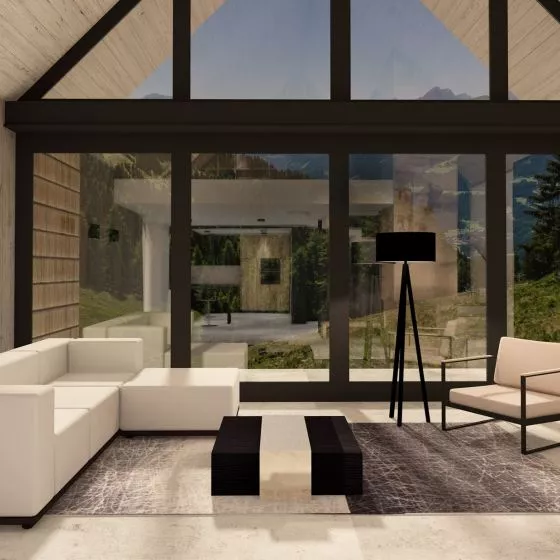A graduate of Interior Design at the Jan Matejko Academy of Fine Arts in Krakow,{tag:studenci}, often walking along the Vistula boulevards and pondering the new pandemic reality, came up with the idea of futuristic public buildings. Enclaves on the Vistula are temporary, enclosed modules made with a 3D printer, enabling remote work.
Agnieszka Białek, founder of Monolight Studio, proposed the Vistula River at the foot of Wawel Castle as the site for the project. The modern blocks contrast with the Royal Castle, but this is only temporary architecture, whose modules can be freely arranged, changing their location on the river.
Enclaves can be placed anywhere on the river
© Agnieszka Białek
The Enclaves project was guided by ecological values. First of all, those related to neutralizing the degradation of natural ecosystems, allowing nature and architecture to coexist. We are still struggling to determine the changes that covid will make in architecture in the long term. What we do know for sure is that we will come to face a new reality. For most companies, remote work has become the norm, which will continue for a long time. As a consequence of this, employees, will have choices about when and how they work. To a large extent, we will see fatigue with home space. We will gladly move the work zone from home to another place," explains the author.
Remote work on the Vistula
The project makes it possible to work remotely, conduct online meetings (videoconferencing) and relax in a new reality, where contact with another person is greatly reduced. When working on the enclaves, the author paid special attention to the inclusion of empty spaces and consideration of users' privacy. The facilities allow for social distance, thus creating a unique comfort zone.
To use the facilities, one must reach them by kayak
© Agnieszka Białek
The way the facilities have been made promotes concentration and the performance of specific tasks. The interiors of the enclaves, thanks to the integrated equipment, allow you to assume any position while working. Thanks to the hourly rental system, the place is friendly for active people both day and night, with no time limits. The enclaves are also protected from outsiders, and must be reached by kayak.
water foam ispiration
When working on the shape of the solids, the architect was inspired by the natural environment. The water foam she observed on the Vistula boulevards created geometric arrangements, which were transferred by the author to the architectural form. The modules consist of enclaves that are part of interconnected cells.
The solids of the objects were inspired by the shape of sea foam
© Agnieszka Białek
An enclave is an enclosed work space, placed on a platform resting on floats. The whole forms a single floating cell. These cells are anchored to the river bed and connected among themselves, allowing modular structures to be created on the surface of the water.
printed modules
The project, made under the direction of Prof. Beata Gibala-Kapecka and Kai Czajczyk, uses new technologies and methods of creation and design. It currently exists as a virtual model, which in the future can be printed on a 3D printer using waterproof, biodegradable filament. The use of 3D printing on an architectural scale allows organic structures to be built in just a few days.
The interiors, thanks to their integrated equipment, allow them to assume any position while working
© Agnieszka Białek
Oblique forms evoke positive associations, creating a sense of security and comfort. My project meets the needs of the times of constant hustle and bustle, creating a kind of oasis of calm. Undoubtedly, the pandemic will influence the formation of new trends in architecture. We already know that it has changed our relationship with work, space and architecture. What changes will it bring in the future? - concludes the author.
compiled by: Dobrawa Bies
based on text by Paula Fronc


































